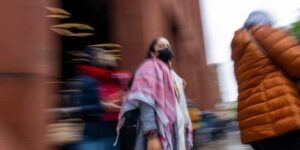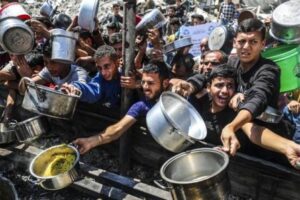The International Socialism Project has held a series of discussions on the rapidly changing US political scene. This article is based on an introduction made to a meeting on September 13. It covers three points: Trump and the far right, the mood of the working class, and the state of the class struggle.
Trump and the far right
Veteran socialist Joel Geier once made a very astute statement on the Holocaust, “The German ruling class needed the Nazis and the Nazis needed the Holocaust.” We can rephrase this statement for today, “The US ruling class benefits from (but does not fundamentally need) Trump and Trump needs the far right.”
What do we mean by this? Outside of Trump’s immediate circle and a few eccentrics, no important wing of the ruling class wishes to do away with bourgeois democracy today. Bourgeois democracy remains the best regime for capital accumulation.
The mainstream of the ruling class has benefited from, and put up with, Trump. They have made great wealth from Trump’s actions on tax cuts, deregulation, and the handouts of the pandemic bailouts. For this reason, they have put up with all of his antics and stupidities and even with a major disagreement on tariffs.
Trump’s authoritarian moves and constant overtures to the far right are purely for cynical electoral reasons, not a long term bourgeois strategy to move to a new form of rule. There is a clear precedent for this in Nixon’s 1968 election campaign. Here we saw, in tandem with the famous Southern Strategy, a massive flaming of racist fears and hysteria. This is what is behind Trump’s war against the BLM demonstrations, the “big cities” and his self-designation as a “law and order” president.
Even though Trump’s encouragement of the far right is an electoral maneuver, it has set uncontrollable forces into motion. The genie can’t be easily put back into the lamp. It’s clears that the far right feels momentum and a sense of upswing today. Remember Frankenstein is not the monster. He’s the doctor who creates the monster that he can no longer control
The far right doesn’t have to have aim for a full smashing of the workers organizations and have the support of big sections of ruling class (as it does in the classic Trotskyist theory of fascism) to be able to create great harm. Kyle Rittenhouse’s Kenosha shooting spree shows the risks in the current situation. The far right is armed, violent, and self- confident.
The same idea of an electoral tactic having deeper repercussions also applies to policing. Trump has used the police and state forces as electoral stage props. Examples of this are the situation in Portland and Trump’s famous June 1 photo-op at St. John’s Episcopal church in Washington. However, these maneuvers have repercussions. They have created a situation of highly militarized responses and hysterical reactions to demonstrations becoming the new normal.
Some Marxists, when discussing whether the Marxist theory of Bonapartism is helpful in understanding Trump, see the use of Homeland Security and other state forces in Portland as the creation of a personal militia for Trump. This is one of the classic features of Bonapartism. Instead, we should see it as an individual bourgeois using part of the state apparatus for his own ends and profits, an American tradition as old as the hills.
None of this analysis should give us any grounds for complacency or relaxation. The fact that today’s situation stems from an individual bourgeois’s wishes does not reduce its gravity. Some “auto-golpe” type operation is certainly a possibility if Trump loses the election. Massive demonstrations in defense of democratic rights will remain high on the revolutionary left’s agenda.
The mood of the working class
At the beginning of the pandemic we used the formulation that “The working class is reeling.” That continues to be the situation today. Let’s go through some of the main points.
• Real unemployment is over 11%, the official rate has declined a little to 8.4%.
• About half of the jobs lost to COVID have not come back.
• United Airlines is only one of the companies raising the prospect of permanent job losses.
• Despite a temporary trough, COVID 19 continues to stalk the country. Now most people know someone who has it.
• Demoralization from unemployment is a continuing factor.
• The next few months will see the running out of unemployment support and eviction prohibitions.
• Medical bills are a growing burden.
• The stresses of looking after children with the coming of online learning are mounting.
• This all takes place against a background of continued decay of social services. The underfunding of the Post Office, even before Dejoy’s shenanigans, and the state the medical system was in even prior to Coronavirus are just two examples of this.
• Urban decay is the backdrop to many workers’ daily lives
• The environmental crisis is reaching fever pitch with the West Coast fires.
All these elements have combined to create an overall mood of uncertainty and anxiety inside the working class. Our formula of “reeling” still hold true six months later. As with everything, we should be careful with this characterization. For example, the crisis has hit different workers in different ways. Black workers are often found in the essential frontline sectors such as transportation and city services. Here, the issues of protective equipment and hazard pay are center stage. Many Latinx workers are in the hospitality and restaurant industry, here questions of unemployment and job security are key. We also see that the unemployment figures have sharp regional variations based on the extent of the shutdown in each area.
Where does the class struggle stand today?
The fightback today falls into two main categories: The Black Lives Matter movement and the more traditional struggles of the labor movement. We should examine each in turn.
Black Lives Matter
It’s clear that the new Black Lives Matter movement is a fundamental and long-term component of the political situation. It was not a one-off, but is here for the duration. It was inevitable that the movement would not stay permanently at the high level of the early summer following George Floyd’s murder. Every mass movement always has highs and lows, ebbs and flows. However, in the past few weeks we have seen:
• The dramatic series of demonstrations in Kenosha after Jacob Blake was shot.
• The very high level of mobilizations in Portland.
• Daniel Prude’s killing in Rochester, NY started a wave of demonstrations in that city.
• The very large rally in Washington DC on the occasion of the fifty- seventh anniversary of the “I Have A Dream” march.
• The highly visible and important boycotts and protests by professional athletes.
All of this confirms our assessment of the depth of this new movement.
Labor Movement
We have seen the following developments in the trade union movement this fall:
• The central bureaucracy appears to have two main focuses. The first is a public relations campaign in defense of essential workers. This quite effective campaign can be seen in the SEIU and Chicago Federation of Labor Day online rallies and the Chicago Sun Times Labor Day special. The other main project of the AFL-CIO leadership is obviously the Biden campaign. This will dominate the federation for the next few months.
• The APWU and NALC have a campaign of pickets in defense of the Post Office.
• The largest strike taking place today in this country is the INA/SEIU strike against the University of Illinois. About 4,000 workers are on strike. Patient ratios are at center stage.
· The wave of semi-spontaneous walk-outs that we saw at the beginning of the virus seem to have largely run their course. Many workplaces are now providing some PPE and cleaning supplies, but have not rebuilt to install greater social distancing. Many employers are putting pressure on employees not to report cases of coronavirus to the press or to fellow workers.
· A high level of activity continues among teachers concerning the conditions for a safe reopening of the schools.
· Opposition caucuses in the labor movement today take two main forms. The first is the Teamsters United campaign supporting Sean O’Brien and Fred Zuckerman in the IBT. Their petition campaign which got 100,000 signatures, during the COVID crisis is a real achievement. Secondly, there are large teacher opposition caucuses inside the NEA and AFT.
Conclusion
This report looked at how Trump’s tactics have emboldened the far right, the difficult situation of the working class, how the BLM movement continues to be a focal point, and how weak the labor movement is today. The real tragedy is that we have no strong revolutionary organization to intervene in this situation. Our task is to contribute to the building of such an organization.



